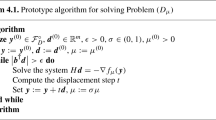Abstract
The paper presents a logarithmic barrier cutting plane algorithm for convex (possibly non-smooth, semi-infinite) programming. Most cutting plane methods, like that of Kelley, and Cheney and Goldstein, solve a linear approximation (localization) of the problem and then generate an additional cut to remove the linear program's optimal point. Other methods, like the “central cutting” plane methods of Elzinga-Moore and Goffin-Vial, calculate a center of the linear approximation and then adjust the level of the objective, or separate the current center from the feasible set. In contrast to these existing techniques, we develop a method which does not solve the linear relaxations to optimality, but rather stays in the interior of the feasible set. The iterates follow the central path of a linear relaxation, until the current iterate either leaves the feasible set or is too close to the boundary. When this occurs, a new cut is generated and the algorithm iterates. We use the tools developed by den Hertog, Roos and Terlaky to analyze the effect of adding and deleting constraints in long-step logarithmic barrier methods for linear programming. Finally, implementation issues and computational results are presented. The test problems come from the class of numerically difficult convex geometric and semi-infinite programming problems.
Similar content being viewed by others
References
O. Bahn, J.L. Goffin, J.-Ph. Vial and O. Du Merle, Implementation and behavior of an interior point cutting plane algorithm for convex programming: An application to geometric programming, Discr. Appl. Math. 49(1994)3–23.
E.W. Cheney and A.A. Goldstein, Newton's method for convex programming and Tchebycheff approximation, Numer. Math. 1(1959)243–268.
I.D. Coope and G.A. Watson, A projected Lagrangian algorithm for semi-infinite programming, Math. Progr. 32(1985)337–356.
J. Elzinga and T.G. Moore, A central cutting plane algorithm for the convex programming problem, Math. Progr. 8(1975)134–145.
A.V. Fiacco and A. Ghaemi, A sensitivity analysis of a nonlinear water pollution control problem using an upper Hudson River database, The George Washington University, Washington, DC (1982).
A.V. Fiacco and A. Ghaemi, A sensitivity and parametric bound analysis of an electric power GP model: Optimal steam turbine exhaust annulus and condenser sizes, serial T-437, The George Washington University, Washington, DC (1981).
J.L. Goffin, A. Haurie and J.-Ph. Vial, Decomposition and nondifferentiable optimization with the projective algorithm, Manag. Sci. 38(1992)284–302.
P.R. Gribik, A central-cutting-plane algorithm for semi-infinite programming problems, in:Semi-Infinite Programming, ed. R. Hettich, Lecture Notes in Control and Information Sciences Vol. 15 (Springer, New York, 1979) pp. 66–82.
J.L. Goffin and J.P. Vial, Cutting planes and column generation techniques with the projective algorithm, J. Optim. Theory Appl. 65(1988)409–429.
P.R. Gribik and D.N. Lee, A comparison of two central cutting plane algorithms for prototype geometric programming problems, in:Methods of Operations Research 31, ed. W. Oettli and S. Steffens (Verlag Anton/Hain/Mannheim, Germany, 1978) pp. 275–287.
S.-A. Gustafson, On numerical analysis in semi-infinite programming, in:Semi-Infinite Programming, ed. R. Hettich, Lecture Notes in Control and Information Sciences Vol. 15 (Springer, New York, 1979) pp. 51–65.
R. Hettich and K.O. Kortanek, Semi-infinite programming: Theory, methods, and applications, Working Paper, FB IV, Universität Trier, Germany (1991).
D. den Hertog,Interior Point Approach to Linear, Quadratic and Convex Programming — Algorithms and Complexity (Kluwer Academic, Dordrecht, The Netherlands, 1994).
D. den Hertog, C. Roos and J.-Ph. Vial, A complexity reduction for the long-step path-following algorithm for linear programming, SIAM J. Optim. 2(1992)71–87.
D. den Hertog, C. Roos and T. Terlaky, A Build-Up variant of the path-following method for LP, Oper. Res. Lett. 12(1992)181–186.
D. den Hertog, C. Roos and T. Terlaky, Adding and deleting constraints in the logarithmic barrier method for linear programming problems, in:Advances in Optimization and Approximation, ed. D. Du and J. Sun (Kluwer Academic, Dordrecht, The Netherlands, 1994) pp. 166–185.
S. Jha, K.O. Kortanek and H. No, Lotsizing and setup time reduction under stochastic demand: A geometric programming approach, Working Paper No. 88-12, College of Business Administration, The University of Iowa, Iowa City, IA (1988).
J. Kaliski and Y. Ye, A decomposition variant of the potential reduction algorithm for linear programming, Manag. Sci. 39(1993)757–776.
J.E. Kelley, Jr., The cutting-plane method for solving convex programs, J. Soc. Ind. Appl. Math. 8(1960)703–712.
K.O. Kortanek, Semi-infinite programming duality for order restricted statistical inference models, Working Paper No. 91-18, College of Business Administration, The University of Iowa, Iowa City, IA (1991).
K.O. Kortanek and H. No, A second order affine scaling algorithm for the geometric programming dual with logarithmic barrier, Optimization 23(1990)303–322. Earlier version: Working Paper No. 90-07, College of Business Administration, The University of Iowa, Iowa City, IA (1990).
K.O. Kortanek and H. No, A central cutting plane algorithm for convex semi-infinite programming problems, SIAM J. Optim. 3(1993)901–918.
N. Megiddo, Pathways to the optimal set in linear programming, in:Progress in Linear Programming, Interior and Related Methods, ed. N. Megiddo (Springer, New York, 1989) pp. 131–158.
J.E. Mitchell and M.J. Todd, Solving combinatorial optimization problems using Karmarkar's algorithm, Math. Progr. 56(1992)245–284.
J. Renegar, A polynomial time algorithm, based on Newton's method, for linear programming, Math. Progr. 40(1988)59–93.
C. Roos and J.-Ph. Vial, A polynomial method of approximate centers for linear programming, Math. Progr. 54(1992)295–305.
Gy. Sonnevend, An “analytic centre” for polyhedrons and new classes of global algorithms for linear (smooth, convex) programming, in:Lecture Notes in Control and Information Sciences Vol. 84 (Springer, New York, 1985) pp. 866–876.
J.-Ph. Vial, Computational experience with a primal-dual interior point method for smooth convex programming, Report April 1993, Département d'Economie Commerciale et Industrielle, Université Genève, Genève, Switzerland (1993), to appear in Optim. Meth. and Softwares.
Y. Ye, A potential reduction algorithm allowing column generation, SIAM J. Optim. 2(1992)7–20.
Author information
Authors and Affiliations
Additional information
This work was completed under the support of a research grant of SHELL.
On leave from the Eötvös University, Budapest, and partially supported by OTKA No. 2116.
Rights and permissions
About this article
Cite this article
den Hertog, D., Kaliski, J., Roos, C. et al. A logarithmic barrier cutting plane method for convex programming. Ann Oper Res 58, 67–98 (1995). https://doi.org/10.1007/BF02032162
Issue Date:
DOI: https://doi.org/10.1007/BF02032162




